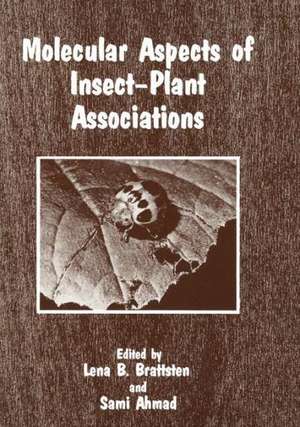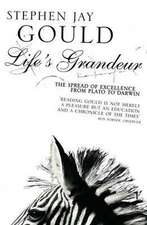Molecular Aspects of Insect-Plant Associations
Autor S. Ahmed, L.B. Brattstenen Limba Engleză Paperback – noi 2011
Preț: 647.73 lei
Preț vechi: 762.04 lei
-15% Nou
Puncte Express: 972
Preț estimativ în valută:
123.94€ • 129.73$ • 103.16£
123.94€ • 129.73$ • 103.16£
Carte tipărită la comandă
Livrare economică 01-15 aprilie
Preluare comenzi: 021 569.72.76
Specificații
ISBN-13: 9781461290407
ISBN-10: 1461290406
Pagini: 360
Ilustrații: XII, 358 p. 10 illus.
Dimensiuni: 178 x 254 x 19 mm
Greutate: 0.62 kg
Ediția:1986
Editura: Springer Us
Colecția Springer
Locul publicării:New York, NY, United States
ISBN-10: 1461290406
Pagini: 360
Ilustrații: XII, 358 p. 10 illus.
Dimensiuni: 178 x 254 x 19 mm
Greutate: 0.62 kg
Ediția:1986
Editura: Springer Us
Colecția Springer
Locul publicării:New York, NY, United States
Public țintă
ResearchCuprins
The Perception of Plant Allelochemicals that Inhibit Feeding.- 1. Introduction.- 2. Insect Feeding Behavior.- 3. The Contact Chemoreceptive System.- 4. Inhibitory Plant Allelochemicals.- 5. Summary.- 6. Acknowledgement.- 7. References.- Allelochemicals and Alimentary Ecology: Heterosis in a Hybrid Zone?.- 1. Introduction.- 2. Hybridization Studies and Experimental Approach.- 3. Results.- 4. Discussion.- 5. Summary.- 6. Acknowledgement.- 7. References.- Enzymes Involved in the Metabolism of Plant Allelochemicals.- 1. Introduction.- 2. Cytochrome P-450.- 3. Other Biological Oxidations.- 4. Biological Reductions.- 5. Hydrolases.- 6. Group Transfer Enzymes.- 7. Summary.- 8. Acknowledegment.- 9. References.- Consequences of Induction of Foreign Compound-Metabolizing Enzymes in Insects.- 1. Introduction.- 2. Induction of Cytochrome P-450-Dependent Monooxygenases.- 3. Induction of Glutathione Transferases.- 4. Induction of Esterases.- 5. Induction of Epoxide Hydrolases.- 6. Consequences of Enzyme Induction.- 7. Summary.- 8. Acknowledgement.- 9. References.- Adaptive Divergence of Chewing and Sucking Arthropods to Plant Allelochemicals.- 1. Introduction.- 2. Plant Resistance to Chewing and Sucking Insects.- 3. Susceptibility Differences to Toxicants.- 4. The Aphid as a Model Phytophage of Phloem Chemicals.- 5. Adaptive Detoxification.- 6. Target Site Selectivities.- 7. Summary.- 8. Acknowledgement.- 9. References.- Fate of Ingested Plant Allelochemicals in Herbivorous Insects.- 1. Introduction.- 2. Terpenes.- 3. Steroids.- 4. Phenylpropanoids.- 5. Flavonoids.- 6. Amino acids.- 7. Cyanogenic Glycosides.- 8. Glucosinolates.- 9. Alkaloids.- 10. Summary.- 11. Acknowledgement.- 12. References.- Target Site Insensitivity in Insect-Plant Interactions.- 1. Introduction.- 2. TSI and Synthetic Insecticides.- 3. TSI in Natural Systems.- 4. Examples of TSI in Insect-Plant Interactions.- 5. Coevolutionary Consequences of TSI.- 6. Summary.- 7. Acknowledgement.- 8. References.- Behavioral Adaptations in Insects to Plant Allelochemicals.- 1. Introduction.- 2. Avoiding Defenses in Time.- 3. Avoiding Defenses in Space.- 4. Mechanisms to Avoid Triggering Defenses.- 5. Overwhelming Plant Defenses.- 6. Blocking Plant Defenses.- 7. The Cost of Avoiding Plant Defenses.- 8. Summary.- 9. Acknowledgement.- 10. References.- Devising Pest Management Tactics Based on Plant Defense Mechanisms, Theoretical and Practical Considerations.- 1. Introduction.- 2. General Strategies to Devising Pest Management Schemes.- 3. Key Processes in Plant-Insect Encounters.- 4. Manipulating Plant-Insect Interactions.- 5. Can Pest Management Tactics Bases on Plant Defenses Favor Stability?.- 6. Summary.- 7. Acknowledgement.- 8. References.













